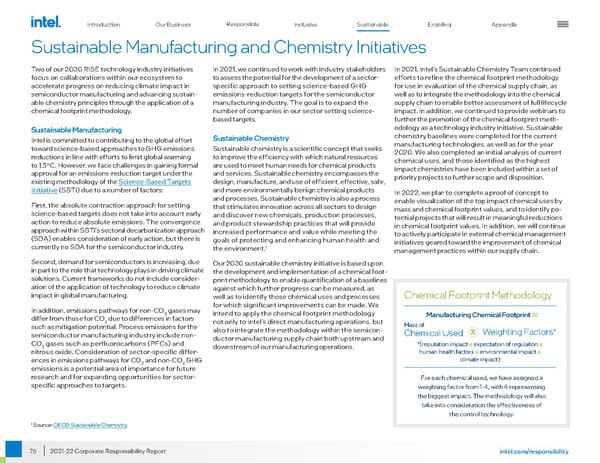76 intel.com/responsibility 2021-22 Corporate Responsibility Report Sustainable Manufacturing and Chemistry Initiatives Two of our 2030 RISE technology industry initiatives focus on collaborations within our ecosystem to accelerate progress on reducing climate impact in semiconductor manufacturing and advancing sustain - able chemistry principles through the application of a chemical footprint methodology. Sustainable Manufacturing Intel is committed to contributing to the global effort toward science-based approaches to GHG emissions reductions in line with efforts to limit global warming to 1.5°C. However, we face challenges in gaining formal approval for an emissions-reduction target under the existing methodology of the Science-Based Targets Initiative (SBTi) due to a number of factors: First, the absolute contraction approach for setting science-based targets does not take into account early action to reduce absolute emissions. The convergence approach within SBTi's sectoral decarbonization approach (SDA) enables consideration of early action, but there is currently no SDA for the semiconductor industry. Second, demand for semiconductors is increasing, due in part to the role that technology plays in driving climate solutions. Current frameworks do not include consider - ation of the application of technology to reduce climate impact in global manufacturing. In addition, emissions pathways for non-CO 2 gases may differ from those for CO 2 due to differences in factors such as mitigation potential. Process emissions for the semiconductor manufacturing industry include non- CO 2 gases such as perfluorocarbons (PFCs) and nitrous oxide. Consideration of sector-specific differ - ences in emissions pathways for CO 2 and non-CO 2 GHG emissions is a potential area of importance for future research and for expanding opportunities for sector- specific approaches to targets. In 2021, we continued to work with industry stakeholders to assess the potential for the development of a sector- specific approach to setting science-based GHG emissions-reduction targets for the semiconductor manufacturing industry. The goal is to expand the number of companies in our sector setting science- based targets. Sustainable Chemistry Sustainable chemistry is a scientific concept that seeks to improve the efficiency with which natural resources are used to meet human needs for chemical products and services. Sustainable chemistry encompasses the design, manufacture, and use of efficient, effective, safe, and more environmentally benign chemical products and processes. Sustainable chemistry is also a process that stimulates innovation across all sectors to design and discover new chemicals, production processes, and product stewardship practices that will provide increased performance and value while meeting the goals of protecting and enhancing human health and the environment. 1 Our 2030 sustainable chemistry initiative is based upon the development and implementation of a chemical foot - print methodology to enable quantification of a baselines against which further progress can be measured, as well as to identify those chemical uses and processes for which significant improvements can be made. We intend to apply the chemical footprint methodology not only to Intel’s direct manufacturing operations, but also to integrate the methodology within the semicon - ductor manufacturing supply chain both upstream and downstream of our manufacturing operations. In 2021, Intel’s Sustainable Chemistry Team continued efforts to refine the chemical footprint methodology for use in evaluation of the chemical supply chain, as well as to integrate the methodology into the chemical supply chain to enable better assessment of full lifecycle impact. In addition, we continued to provide webinars to further the promotion of the chemical footprint meth - odology as a technology industry initiative. Sustainable chemistry baselines were completed for the current manufacturing technologies, as well as for the year 2020. We also completed an initial analysis of current chemical uses, and those identified as the highest impact chemistries have been included within a set of priority projects to further scope and disposition. In 2022, we plan to complete a proof of concept to enable visualization of the top impact chemical uses by mass and chemical footprint values, and to identify po - tential projects that will result in meaningful reductions in chemical footprint values. In addition, we will continue to actively participate in external chemical management initiatives geared toward the improvement of chemical management practices within our supply chain. Chemical Footprint Methodology Manufacturing Chemical Footprint = Mass of Chemical Used x Weighting Factors* For each chemical used, we have assigned a weighting factor from 1-4, with 4 representing the biggest impact. The methodology will also take into consideration the effectiveness of the control technology. *(reputation impact x expectation of regulation x human health factors x environmental impact x climate impact) 1 Source: OECD Sustainable Chemistry . Introduction Our Business Responsible Inclusive Sustainable Enabling Appendix
 Intel Corporate Responsibility Report Page 75 Page 77
Intel Corporate Responsibility Report Page 75 Page 77